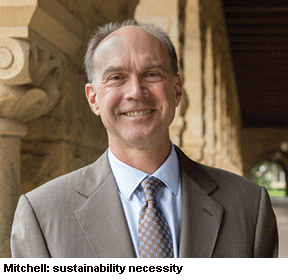FEW INSTITUTIONS ARE AS CLOSELY associated with the massive open online courses (Moocs) movement as Stanford University. But could monetising Moocs, particularly in professional development courses, be the next step for the California-based institution? Two of the best-known US Moocs platforms, Coursera and Udacity, were conceptualised by Stanford professors, and the university’s location in the heart of Silicon Valley places it in close proximity to many of the world’s leading tech companies.
 John Mitchell is vice-provost for online learning and overseer of Stanford’s Moocs programme, which has delivered more than 240 online and blended campus courses to about 2 million people since 2011 — more than 50 of them free of charge. “Moocs have started out as a free opportunity — and free is a great way to get people interested,” he says. “But traditionally, students in the US pay tuition to go to college or university and I don’t think it is unreasonable to ask people to pay a little bit for education that helps them to move forward in their careers.” Prof. Mitchell, who is an instructor on a computer security Mooc offered by Stanford on the Coursera platform, says that professional development courses offer universities the best opportunity to grow the income they generate from online courses.
John Mitchell is vice-provost for online learning and overseer of Stanford’s Moocs programme, which has delivered more than 240 online and blended campus courses to about 2 million people since 2011 — more than 50 of them free of charge. “Moocs have started out as a free opportunity — and free is a great way to get people interested,” he says. “But traditionally, students in the US pay tuition to go to college or university and I don’t think it is unreasonable to ask people to pay a little bit for education that helps them to move forward in their careers.” Prof. Mitchell, who is an instructor on a computer security Mooc offered by Stanford on the Coursera platform, says that professional development courses offer universities the best opportunity to grow the income they generate from online courses.
“I think (Stanford) will have low cost, high volume, but non-free courses online that will help make our online programmes sustainable,” he says, adding that no college or university can continue funding free courses without finding a way to cover costs.
This, Mitchell continues, is despite the fact that free online courses help to make the expertise of his university more visible to the general public — something that is in itself valuable to the institution. “If someone has an idea that’s useful to the world, spreading that idea is part of our mission,” he says.
But now, universities will need to explore ways of charging for large online courses, even though doing so reduces the “openness” of any so-called Mooc. “One of the issues we have with Moocs is that it can be very difficult to set up successful group projects when people keep leaving the course,” he says, referring to the fact that completion rates for free online courses are typically very low.
Grades inflation confusion
“WE DO NOT RELEASE STATISTICS ON grade-point averages so we can’t speak to the accuracy of the information you have.” That was a byte from Yale, but other Ivy League colleges — with the partial exception of Princeton — are equally reluctant to discuss their grading practices with The Economist.
Stuart Rojstaczer, a critic of grade inflation, has estimated average grades over time by combining dozens of unofficial and official sources. The results are startling. In 1950, Rojstaczer estimates, Harvard’s average grade was a C-plus. An article from 2013 in the Harvard Crimson, a student newspaper, revealed that the median grade has soared to A-minus with the most commonly awarded grade being an A. Students may be much cleverer than before: the Ivies are no longer gentlemen’s clubs for rich knuckleheads. But most probably, their marks mean less.
Universities pump up grades because many students like it. Administrators claim tough grading leads to rivalry and stress for students. But if that’s true, why have grades at all? Brilliant students complain that, thanks to grades inflation, little distinguishes them from their so-so classmates. Employers agree. When so many students get As, it’s hard to figure out who’s clever and who’s not.
(Excerpted and adapted from Times Higher Education and The Economist)